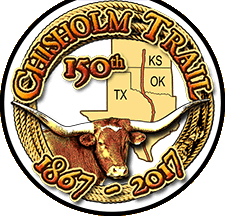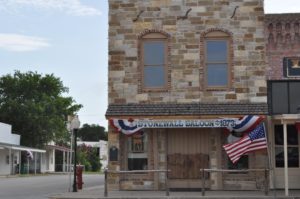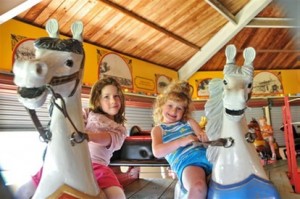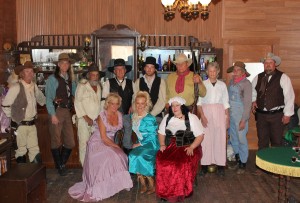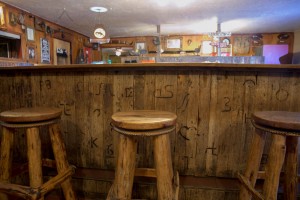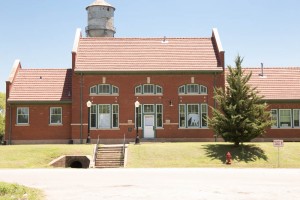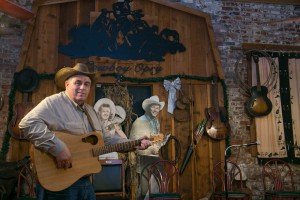Shop, See, Stay, Do, Learn, Laugh
The easiest way to enter or update your listing is to send an email to [email protected] with 3-5 photos and all pertinent information.
- Attractions (17)
- Family Fun (17)
- Tour Bus Friendly (10)
- Specialty Shopping (10)
- Performers/Speakers/Poets (7)
- Dining (4)
- Community Information (3)
- Camping/RV Parks (2)
- Lodging (1)
- Landmark (0)
An 18-acre, 215,000 sq-ft learning center exploring Oklahoma's unique history.
Looking for a cozy couch, fancy new dining set, lamps or artwork for the walls? You'll find it at Eclectic Echo Furniture Consignment Gallery on Main Street Duncan in Oklahoma. Owned and operated by Debbie Sledge, you'll find designer, name brand furniture for a whole lot less.
"It is always changing. We tell people if they see something they want, they better get it because it probably won't be here the next time they come through," says Debbie. She also gets new items in, and carries Howard's Furniture products.
Eclectic Echo's vibe is warm, cozy and friendly. It is a consignment store with new pieces in daily. Currently located at 825 & 827 Main Street, Duncan.
You'll get a western welcome when you walk in the door of the Buzzard's Nest Trading Post in Comanche, Oklahoma, and a ya'll come back now, when you leave. Owned by sole proprietor Diane Gann, established in 2007, the Buzzard's Nest has everything from new handbags to unusual found jewelry and antiques, home decor, the latest in fashions, and so much more.
"We have lots of friendly faces, it's a family run business unless the family runs away," says Diane. "Every time you visit you will find new items."
Welcome to the Chisholm Trail Outdoor Museum. The tepees and life size cattle drive silhouettes that greet you as you enter the museum along with the “WELCOME TO CLEBURNE * ON THE CHISHOLM TRAIL” eighty foot stone wall are fast becoming one of the most recognized and photographed landmarks in this part of Texas. We offer free docent-led tours with advance notice on Mondays, Thursdays, Fridays, Saturdays and Sundays.
Chisholm Trail Ridge Park lies along the scenic shore of Waurika Lake in the Great Plains Region of southern Oklahoma. The area offers many recreation activities, including fishing, boating and hunting.Waurika Lake encompasses 10,100 acres of water and about 12,000 acres of land, which provide ample space for visitors to enjoy the outdoors. It is about six miles northwest of the city of Waurika and lies in portions of Jefferson, Cotton and Stephens Counties.This facility is named after the Chisholm Trail, a trail used to transport cattle from Texas ranches to Kansas railroads in the late 1800s.****NOTE TO VISITORS: Oklahoma and northern Texas are in a period of drought. Lakes are at very low levels.Getting There:GPS Info. (Latitude, Longitude):34.25917, -98.03534°15'33"N, 98°2'6"WFrom Waurika, Oklahoma, take Highway 5 northwest for 5 miles. Turn right onto Advent Road and proceed 3 miles. Turn left on Chisholm Trail Road and drive one mile to the park entrance.
The Williamson Museum is a 501(c)(3) non-profit corporation established in 1997 to collect, preserve and exhibit items relating to the rich culture and heritage of Williamson County. We offer free and exciting hands-on educational programs to the public through innovative exhibits, tours and outreach including our annual Chisholm Trail Days Event at San Gabriel Park and Pioneer Day at Old Settlers Park.
Through our extensive educational outreach programs, our goal is to preserve the unique stories of the county for both present and future generations. In addition, the Museum provides insight and accurate historical information based on first-hand sources in a variety of areas. This focus allows the Museum to effectively educate, entertain and enlighten our visitors.
Recognizing that our past profoundly influences our future the Bell County Museum collects, preserves and interprets the historic and prehistoric cultural heritage of the Bell County region, for all citizens, and provides quality traveling exhibitions for their enjoyment and education.
Established in 1991, the Bell County Museum serves the community as a vital resource for the collection, interpretation and preservation of the historical heritage of the Bell County area.
This small park pays tribute to the cattle drives along the Chisholm Trail. This was the last stop in Texas before heading to northern markets using The Great Texas Cattle Trails, including the Chisholm and Goodnight trails. Nine life-size longhorns and two roving cowboys, made of steel, recall those early cattle drives. Wise Street at U.S. 81.
- See more at: http://texaslakestrail.com/plan-your-adventure/historic-sites-and-cities/sites/chisholm-trail-memorial-park#sthash.2GunFd9s.dpuf
Experience the world’s only twice daily cattle drive as Fort Worth’s herd of Texas Longhorn steers are driven down the bricks of historic Exchange Avenue in the Historic Fort Worth Stockyards. The Herd is driven by authentic cowboys and cowgirls in period clothing from the era of 1865.
- See more at: http://texaslakestrail.com/plan-your-adventure/historic-sites-and-cities/sites/fort-worth-herd-cattle-drive#sthash.xaPjBhZr.dpuf
The Fort Worth Stock Yards, officially incorporated in 1893, swiftly became the epicenter of the largest livestock market in Texas, grew to be the biggest market south of Kansas City, and finally ranked among the top five nationwide for five decades. Serving as supply depot for the Chisholm Trail, the major route out of Texas for livestock, started Fort Worth on its path to Cowtown capital. But it was the arrival of the railroad and the ambition of its business leaders that drove the city’s success. Recognizing the potential, local businessmen began expanding the stockyard facilities beyond its feedlots. Diversification in Fort Worth’s livestock industry included railroad cattle terminals, meatpacking plants, grain elevators for feed, livestock-pharmaceutical manufacturers, a horse, mule, and hog market, and its expansion into sheep soon turned it into the largest sheep market in the nation. A permanent change in the nature of the livestock industry and its decentralization wouldn’t begin until the middle of the 20th century, allowing the Fort Worth Stockyards to hold on until 1992, when the market finally closed after its final livestock auction. However, rather than allowing the enterprise to go the way of other abandoned stockyards in the state, Fort Worth business leaders once again saw opportunity for growth and today a Stockyards National Historic District, with its restored mercantile buildings and network of corrals and feedlots, preserves the city’s grand past. The District covers fifteen square blocks where entertainment, restaurants, shops, a daily cattle drive, and rodeos all drive a visitor experience worthy of Texas’ Cowtown Capital.
- See more at: http://texaslakestrail.com/plan-your-adventure/historic-sites-and-cities/sites/stockyards-national-historic-district#sthash.hCLzRHnC.dpuf
The Cattle Raisers Museum chronicles Texas ranch life through film, photos, interactive exhibits and displays of ranching memorabilia. Visitors can trace the origins and development of ranching as both an industry and cultural phenomenon in the 1850s and embark on a journey through the cattle industry and into the future of the business. The interactive gallery tells the story of the challenges and accomplishments of Texas and Southwestern cattle raisers over the past 150 years.
- See more at: http://texaslakestrail.com/plan-your-adventure/historic-sites-and-cities/sites/cattle-raisers-museum#sthash.9wZJqaWF.dpuf
CHISHOLM COLLECTION
If read out of context, the Historic Round Rock Collection sounds like a historically significant collection of rocks. It’s not, although one rock in particular, a large table-shaped rock along a Brushy Creek low water crossing, provided the town its name. Rather, it is a collection of historic sites commemorating Round Rock’s history, including those sites connected to the Chisholm Trail. The famous trail crossed Brushy Creek near the infamous round rock and some of the town’s period businesses serviced the wranglers and drovers who followed the trail. Approximately nine sites, including several homes, an inn, a hotel that also served as a post office, and the actual round rock, of course, are among the collection. Round Rock is fortunate to retain a good percentage of its early architecture and much of the historic downtown buildings were constructed between 1876 and 1881. Chisholm Trail associated buildings, including the St Charles Hotel, were built as early as 1850 and remain standing today.
- See more at: http://texasbrazostrail.com/plan-your-adventure/historic-sites-and-cities/sites/chisholm-trail-historic-district#sthash.9egn9Vnb.dpuf
The Stonewall Saloon was the first permanent structure built in Saint Jo in 1873 to accommodate thirsty trail drovers moving cattle along the Chisholm Trail. It maintained a boarding house upstairs. It now serves as a museum depicting the history of Saint Jo and the Chisholm Trail.
Physical Address is 100 Main St, Saint Jo, Tx. Mailing address is PO Box 518, Saint Jo, TX 76265.
Discover the history of the wild frontier, the days of Tom Smith and Wild Bill Hickok, and the wild and woolly days of the cattle drives to Abilene at the end of the Chisholm Trail. Also explore the stories of the early pioneers as they settled the great plains and turned the great American desert into their home. Extensive archival documents/records. Historic displays, antique carousel, blacksmith shop, cowboy history, family research, and telephony museum.
Our C.W. Parker Carousel was built in 1901, complete with hand-carved horses, is our pride and joy at the Dickinson County Heritage Center.
C.W. Parker's fascination with carousels first began when he came across one while on a walk with his young daughter. After purchasing multiple rides for her, Parker decided the amusement business would be a good venture for him. Parker bought his first carousel soon after, and later decided to try to improve the design by building his own. Thus the C.W. Parker Amusement Company began.
Our 1901 carousel was manufactured here in Abilene, Kansas and originated as a traveling carnival ride. It was sold to Tom Knight, a drive-in movie theater owner in Riverton, Wyoming. When Knight's health declined and forced him to close, the Dickinson County Historical Society was contacted to purchase and bring the carousel back home to Abilene. After ten years and many volunteer hours, the carousel became fully restored and was named a National Historic Landmark. It is one of only twelve National Historic Carousels in the United States.
Every year thousands of people enjoy a ride on the carousel which comes with a replica ticket souvenir.
The Clearwater Historical Society was started in 1979. It took ten years of fundraising to complete the museum in November 1990. Within 6 years nearly 8,000 items were placed in the museum.
In the original part of the museum a "house" was created, which has 2 bedrooms, a kitchen, bath, dining room, and parlor. There are many other attractions such as: the Military Room, Summer Kitchen, Laundry Room, School Room, Doctor/Dentist Office, and General Store.
The museum is equipped with restrooms, excellent lighting, air conditioning, and heating. It is handicap accessible. The museum is a great place to come and visit, and is open on Sundays from 1:00-4:00 pm.
Learn the history of the Chisholm and Santa Fe Trail as experienced by settlers and cattle drovers coming west. Board a modern day covered wagon (tram) and learn about the days of pioneers coming west and cowboys driving their herds from Texas to Abliene. Historical marker located 3 miles east of Canton commerates where Trails meet. Santa Fe Trail marker 1/4 mile south of Canton. Another site is the historic Jones cemetery located on the Santa Fe Trail just east of Canton.
In the heart of downtown Wichita, the Museum is located in the original 1890 City Hall with its 170-foot tall clock tower. This exceptional, AAM-accredited museum features four floors of special and long-term exhibits examining Wichita and Sedgwick County’s rich history and cultural heritage. The museum’s collection of 70,000 artifacts includes a Wichita-built 1916 Jones Six automobile, a full-scale Victorian home interior and many other exhibits embodying the area’s vibrant history from its settlement in the 1860s to the era of aviation and electric guitars. Special and traveling exhibits ensure you experience something new since your last visit; see the Museum’s website for details: wichitahistory.org. Museum & Gift Shop open Tuesday-Friday 11 a.m. to 4 p.m.; Sat. & Sunday 1 to 5 p.m. Admission: $5 adults, $2 children (6-12).
Original gravestones of Caldwell's gunslingers and first settlers located in a special area in the Caldwell Cemetery. Historical marker tells the story.
A whole heap (herd?) of cowboy and western performers including singers, tricksters, gun fighters, saloon girls and more. They can come to your event, or your group can come to their Western Town east of Marlow, OK. Contact Orvel Robinson for details.
Travel: State of Oklahoma
Fees: Dependent on number of performers, travel and duration of performance
Whether you're planning a family vacation, group event or corporate gathering, Enid has plenty of fun things to do and lodging options ranging from popular chain hotels to historic bed and breakfast inns. Our location at the junction of U.S. highways 81 and 412 is not only easily accessible; it has significant historical value. Enid is right where the paths of the Chisholm Trail and Cherokee Strip Land Run cross. If you love movies, think Lonesome Dove meets Far and Away.
Local ranch brands are burned into the counter, vintage western paintings, handmade spurs and bits adorn the walls of this small diner just south of Terral, Oklahoma. Catfish, chicken strips, calf fries and steak finger sandwiches are a few of the short menu items. Dessert is pies. Beer is ice cold! Tartar sauce like nobody’s business. Doug’s T-shirts are a popular item with travelers. Opened since 1948, 11 a.m. to 9 p.m. Tuesday through Sunday.
In 1912, the Depot became the hub of the community. Brick pavers surround the north side, between the building and the railroad. The city now owns the building and a public library is open during the week. Inside there is a room dedicated to its railroad history, serving as a museum, and numerous historical photographs of the region are displayed throughout the library. It is listed on the National Register of Historic Buildings. It also serves as a public town hall meeting place for legislators and as events center for everything from art shows to wedding receptions.
Welcome to Oklahoma's Chisholm Trail Centennial Corridor sign was established in 2007 for the state Centennial celebration. The highlight was a month long cattle drive, from the Red River north into Kansas.
Store proprietor Allen Wooten has been collecting instruments and country music memorabilia for over 10 years. Much of his instrument collection is for sale. Every Thursday evening, he hosts an acoustic session in his Cowboy Opry venue, along with something to eat if you’re hungry. It’s kind of like the Bluebird Café of Southern Oklahoma. There’s plenty of stories, music and things to see and share at this little store which sits at the intersection of US Highway 81 and Oak Main in Comanche. He also offers music lessons for those who want to learn a lil’ pickin’.
